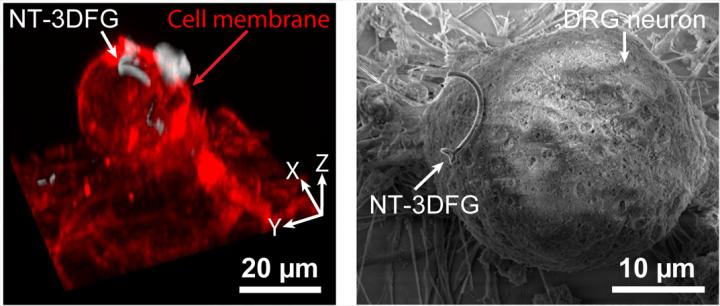A remote control for neurons

Nanowires are able to stimulate neurons from outside the cell membrane. Credit: Carnegie Mellon University College of Engineering
Graphene is abundant, cheap, and biocompatible. Cohen-Karni's lab has been working with graphene for several years, developing a technique of synthesizing the material in 3D topologies that he's labeled “fuzzy” graphene.
By growing two-dimensional (2D) graphene flakes out-of-plane on a silicon nanowire structure, they're able to create a 3D structure with broadband optical absorption and unparalleled photothermal efficiency.
These properties make it ideal for cellular electrophysiology modulation using light through the optocapacitive effect. The optocapacitive effect alters the cell membrane capacitance due to rapidly applied light pulses. NT-3DFG can be readily made in suspension, allowing the study of cell signaling within and between both 2D cell systems and 3D, like human cell-based organoids.
Systems like these are not only crucial to understanding how cells signal and interact with each other, but also hold great potential for the development of new, therapeutic interventions.
Exploration into these opportunities, however, has been limited by the risk of cellular stress that existing optical remote-control technologies present. The use of NT-3DFG eliminates this risk by using significantly less energy, on a scale of 1-2 orders of magnitude less.
Its biocompatible surface is easy to modify chemically, making it versatile for use with different cell types and environments. Using NT-3DFG, photothermal stimulation treatments could be developed for motor recruitment to induce muscle activation or could direct tissue development in an organoid system.
“This is an outstanding collaborative work of experts from multiple fields, including neuroscience through Pitt and UChicago, and photonics and materials science through UNC and CMU,” said Cohen-Karni.
“The developed technology will allow us to interact with either engineered tissues or with nerve or muscle tissue in vivo. This will allow us to control and affect tissue functionality using light remotely with high precision and low needed energies.”
Additional contributions to the project were made by Maysam Chamanzar, assistant professor of electrical and computer engineering. His team's core expertise in photonics and neurotechnologies assisted in developing the much-needed tools to allow both the characterization of the unique hybrid-nanomaterials, and in stimulating the cells while optically recording their activity.
“The broadband absorption of these 3D nanomaterials enabled us to use light at wavelengths that can penetrate deep into the tissue to remotely excite nerve cells. This method can be used in a whole gamut of applications, from designing non-invasive therapeutics to basic scientific studies,” said Chamanzar.
The team's findings are significant both for our understanding of cell interactions and the development of therapies that harness the potential of the human body's own cells. Nanostructures created using NT-3DFG may have a major impact on the future of human biology and medicine.
###
Other team members involved in the research included Biomedical Engineering Ph.D. student Sahil Rastogi; Materials Science and Engineering Ph.D. students Raghav Garg and Daniel San Roman and master's student Nicholas Johnson; ECE Ph.D. student Matteo Giuseppe Scopelliti; the University of Chicago's Francisco Bezanilla and Bernardo Pinto; the University of Pittsburgh's Jane Hartung and Michael Gold; and the University of North Carolina's Seokhyoung Kim, Corban Murphey, and James Cahoon.
Media Contact
All latest news from the category: Materials Sciences
Materials management deals with the research, development, manufacturing and processing of raw and industrial materials. Key aspects here are biological and medical issues, which play an increasingly important role in this field.
innovations-report offers in-depth articles related to the development and application of materials and the structure and properties of new materials.
Newest articles

High-energy-density aqueous battery based on halogen multi-electron transfer
Traditional non-aqueous lithium-ion batteries have a high energy density, but their safety is compromised due to the flammable organic electrolytes they utilize. Aqueous batteries use water as the solvent for…

First-ever combined heart pump and pig kidney transplant
…gives new hope to patient with terminal illness. Surgeons at NYU Langone Health performed the first-ever combined mechanical heart pump and gene-edited pig kidney transplant surgery in a 54-year-old woman…

Biophysics: Testing how well biomarkers work
LMU researchers have developed a method to determine how reliably target proteins can be labeled using super-resolution fluorescence microscopy. Modern microscopy techniques make it possible to examine the inner workings…





















